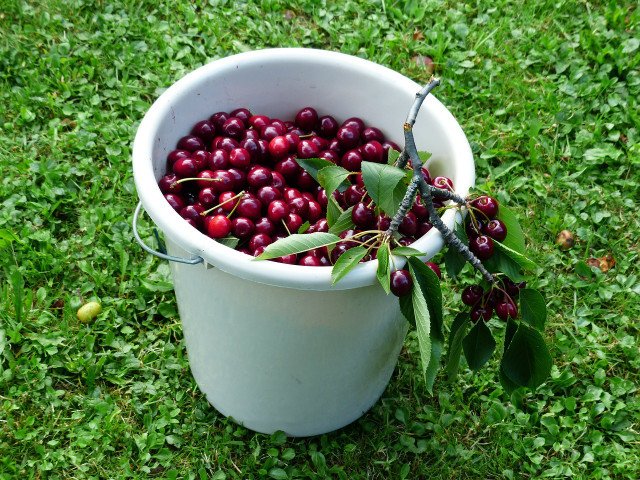Thanks to its numerous flowers and fruits, the bird cherry is an important nutrient tree for insects and birds. In this article we will show you how to plant the wild cherry in your garden.
The bird cherry belongs to the rose family and is considered the progenitor of the sweet cherry bred from it. You can either use the wild cherry as a fruit tree or grow it in a natural garden as an important nutrient wood for birds. In spring, the numerous white blossoms make the bird cherry not only a beautiful eye-catcher, but also an important food source for insects. With the bird cherry, you can thus turn your garden into a valuable bee pasture.
In summer, the black-red shiny fruits appear on the branches. The cherries taste slightly sweet with a bitter note and are especially popular with birds. Therefore, if you are looking for a taller growing hedge and you care about an insect and bird friendly garden, the bird cherry is just the right choice for you.
Contents
Planting bird cherry: how to do it right
If you want to plant a bird cherry in your garden, you should look for grafted species in the garden center. These grow particularly compactly and do not spread as much as wild cherries found in nature. If you have decided on a young tree, you should observe the following tips before planting it in the ground:
Location: The bird cherry is very tolerant of heat and drought, so it will do well in a full sun spot in the garden. Young trees should be protected from full sun for the first few years. The bird cherry can be planted as a solitary or in groups without any problems. The wild shrub is also well suited as a dense-growing hedge.
Soil: Bird cherry thrives best in deep, loose soil with a high humus content. The soil should also be as calcareous as possible.
Planting the bird cherry correctly: It is best to plant the young bird cherry in early spring or fall. When selecting a site, make sure that the fruit tree can grow up to 15 meters high over the years.
- Pot up the young bird cherry tree and place it in a tub of water. Let it soak there until no more air bubbles rise.
- Now dig the planting hole at the intended location. Make sure that the hole is twice as big as the root ball of the cherry.
- Mix some compost into the excavated soil.
- Place the bird cherry tree in the hole and refill it with the compost-soil mixture.
- Additionally, stick a wooden support stick into the soil and tie the bird cherry loosely to it to give it more support during the first few weeks.
- Press down the top layer of soil and water the fruit tree generously.
Proper care for the bird cherry
Once the bird cherry is in the right place, it does not require too much care. It therefore fits well into a low-maintenance garden. With the following care tips, you can ensure that you and the birds in the area have something from the edible wild shrub for as long as possible:
- Watering: Make sure that the soil of the bird cherry never dries out completely. In the summer, you can support the fruit tree regularly with small amounts of water. However, you should avoid waterlogging at all costs.
- Fertilize: Once a year, you should mulch the soil around the bird cherry with compost. This ensures that the soil retains water and nutrients better. If necessary, you can also work the compost deeper into the soil.
- Pruning: The vigorous-growing bird cherry depends on regular pruning so that it can produce numerous fruits. It is best to prune the crown once a year in summer, as soon as you have harvested the cherries. Cut back any branches that hang down into the crown or grow steeply upwards. Also, always prune above the vigorous young side shoots to evenly thin out the crown.
- Wintering: As a rule, the bird cherry is frost hardy. In extreme sub-zero temperatures, however, the trunk can crack. You can protect the wild shrub from this with a coat of lime. You can wrap young bird cherries with straw mats or fleece to prevent frost damage.
- Diseases and pests: If the leaves of your bird cherry curl, this can be an indication of aphids. In addition, the cherry vinegar fly, bark beetle and ants can be dangerous to the fruit tree. You can protect the bird cherry from the shotgun disease caused by fungi, for example, by regularly thinning out the crown. This allows the leaves to dry better after rain and makes them less susceptible to fungus.
Bird cherry: harvest and use of the fruit

The dark red fruits of the bird cherry are popular with both birds and us humans because of their sweet taste. The cherries are only about an inch in diameter and ripen in June and July. During these two summer months, you can harvest the ripe bird cherries. Make sure that you always pick the cherries with the stem, if possible, to avoid cherry stains on your clothes and your fingers. After harvesting, you should wash and pit the bird cherries thoroughly before eating them. However, the sweet fruits are also good for further processing. To make them last longer, you can preserve the cherries. The amount of other recipes for bird cherries is large and includes:
- freshly squeezed cherry juice
- jam or cherry jelly
- cherry vinegar
- Cherry liqueur
- Cherry cake (in another article you will find, for example, a delicious recipe for chocolate cherry cake)
Tip: Always leave a few cherries hanging on the tree. The birds in your garden will gratefully help themselves to this additional food source.

